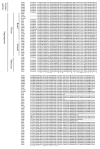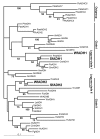Molecular phylogeny and evolution of alcohol dehydrogenase (Adh) genes in legumes
- PMID: 15836788
- PMCID: PMC1112602
- DOI: 10.1186/1471-2229-5-6
Molecular phylogeny and evolution of alcohol dehydrogenase (Adh) genes in legumes
Abstract
Background: Nuclear genes determine the vast range of phenotypes that are responsible for the adaptive abilities of organisms in nature. Nevertheless, the evolutionary processes that generate the structures and functions of nuclear genes are only now be coming understood. The aim of our study is to isolate the alcohol dehydrogenase (Adh) genes in two distantly related legumes, and use these sequences to examine the molecular evolutionary history of this nuclear gene.
Results: We isolated the expressed Adh genes from two species of legumes, Sophora flavescens Ait. and Wisteria floribunda DC., by a RT-PCR based approach and found a new Adh locus in addition to homologues of the Adh genes found previously in legumes. To examine the evolution of these genes, we compared the species and gene trees and found gene duplication of the Adh loci in the legumes occurred as an ancient event.
Conclusion: This is the first report revealing that some legume species have at least two Adh gene loci belonging to separate clades. Phylogenetic analyses suggest that these genes resulted from relatively ancient duplication events.
Figures



References
-
- Miyashita NT. DNA variation in the 5' upstream region of the Adh locus of the wild plants Arabidopsis thaliana and Arabis gemmifera. Mol Biol Evol. 2001;18:164–171. - PubMed
-
- Dolferus R, Bruxelles GD, Dennis ES, Peacock WJ. Regulation of the Arabidopsis Adh gene by anaerobic and other environmental stress. Ann Bot. 1994;74:301–308. doi: 10.1006/anbo.1994.1121. - DOI
Publication types
MeSH terms
Substances
Associated data
- Actions
- Actions
- Actions
- Actions
- Actions
- Actions
LinkOut - more resources
Full Text Sources

